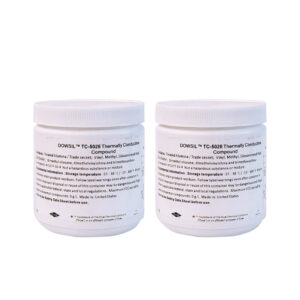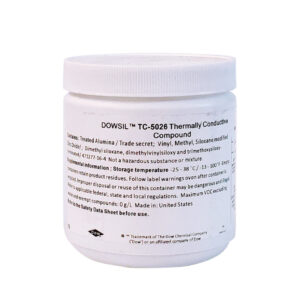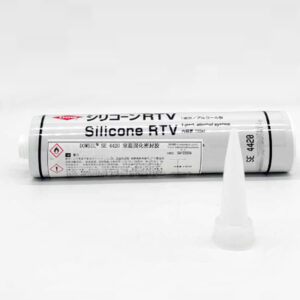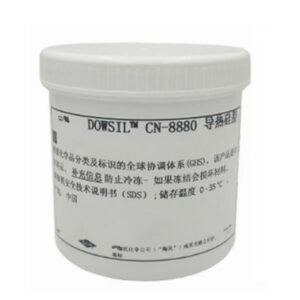-
Dow corning DOWSIL SE 4450 Thermally Conductive Adhesive
Dow thermally conductive compounds are grease like silicone materials, heavily filled with heat-conductive metal oxides. This combination promotes high thermal conductivity, low
bleed and high-temperature stability. The compounds are designed to maintain a positive heat sink seal to improve heat transfer from the electrical device or PCB system assemblies
to the heat sink or chassis, thereby increasing the overall efficiency of the device. or PCB system assemblies are continually designed to deliver higher performance. Especially in the area of consumer devices, there is also a continual trend towards smaller, more compact designs. In combination these factors typically mean that more heat is generated in the device. Thermal management of PCB system assemblies is a primary concern of design engineers. A cooler device allows for more efficient operation and better reliability over the life of the device. As such, thermally conductive compounds play an integral role here. Thermally conductive materials act as a thermal “bridge” to remove heat from a heat source (device) to the ambient via a heat transfer media (i.e. heat sink). These materials have properties such as low thermal resistance, high thermal conductivity, and can achieve thin Bond Line Thicknesses (BLTs) which can help to improve the transfer of heat away from the device. -
Dow corning DOWSIL TC-5026 Thermally Conductive Compound
Dow thermally conductive compounds are grease like silicone materials, heavily filled with heat-conductive metal oxides. This combination promotes high thermal conductivity, low
bleed and high-temperature stability. The compounds are designed to maintain a positive heat sink seal to improve heat transfer from the electrical device or PCB system assemblies
to the heat sink or chassis, thereby increasing the overall efficiency of the device. or PCB system assemblies are continually designed to deliver higher performance. Especially in the area of consumer devices, there is also a continual trend towards smaller, more compact designs. In combination these factors typically mean that more heat is generated in the device. Thermal management of PCB system assemblies is a primary concern of design engineers. A cooler device allows for more efficient operation and better reliability over the life of the device. As such, thermally conductive compounds play an integral role here. Thermally conductive materials act as a thermal “bridge” to remove heat from a heat source (device) to the ambient via a heat transfer media (i.e. heat sink). These materials have properties such as low thermal resistance, high thermal conductivity, and can achieve thin Bond Line Thicknesses (BLTs) which can help to improve the transfer of heat away from the device. -
Dow corning DOWSIL™ SE 4420 Thermally Conductive Adhesive
- One-part RTV-cure thermally conductive materials cure with moisture exposure to produce durable, relatively low-stress elastomer with a noncorrosive by-product. PCB system
assemblies are continually designed to deliver higher performance. Especially in the area of consumer devices, there is also a continual trend towards smaller, more compact designs. In combination these factors typically mean that more heat is generated in the device. Thermal management of PCB system assemblies is a primary concern of design engineers.
- One-part RTV-cure thermally conductive materials cure with moisture exposure to produce durable, relatively low-stress elastomer with a noncorrosive by-product. PCB system
-
DOWSIL CN-8880 white thermal conductive silicone computer CPU graphics card heat dissipation paste thermal conductive silicone
Dow thermally conductive compounds are grease like silicone materials, heavily filled with heat-conductive metal oxides. This combination promotes high thermal conductivity, low
bleed and high-temperature stability. The compounds are designed to maintain a positive heat sink seal to improve heat transfer from the electrical device or PCB system assemblies
to the heat sink or chassis, thereby increasing the overall efficiency of the device. or PCB system assemblies are continually designed to deliver higher performance. Especially in the area of consumer devices, there is also a continual trend towards smaller, more compact designs. In combination these factors typically mean that more heat is generated in the device. Thermal management of PCB system assemblies is a primary concern of design engineers. A cooler device allows for more efficient operation and better reliability over the life of the device. As such, thermally conductive compounds play an integral role here. Thermally conductive materials act as a thermal “bridge” to remove heat from a heat source (device) to the ambient via a heat transfer media (i.e. heat sink). These materials have properties such as low thermal resistance, high thermal conductivity, and can achieve thin Bond Line Thicknesses (BLTs) which can help to improve the transfer of heat away from the device.








